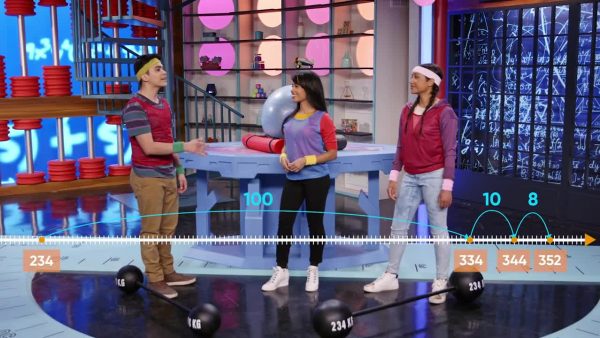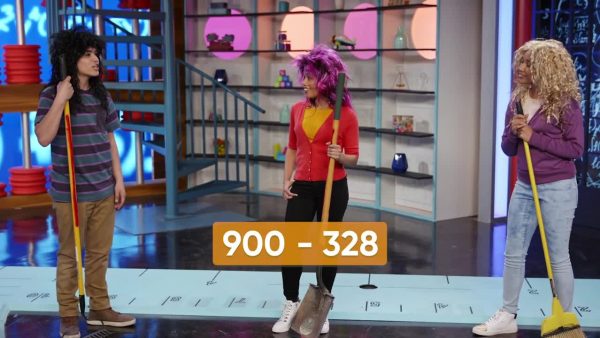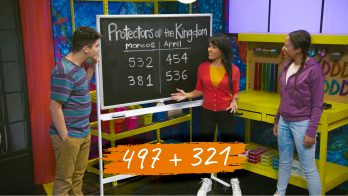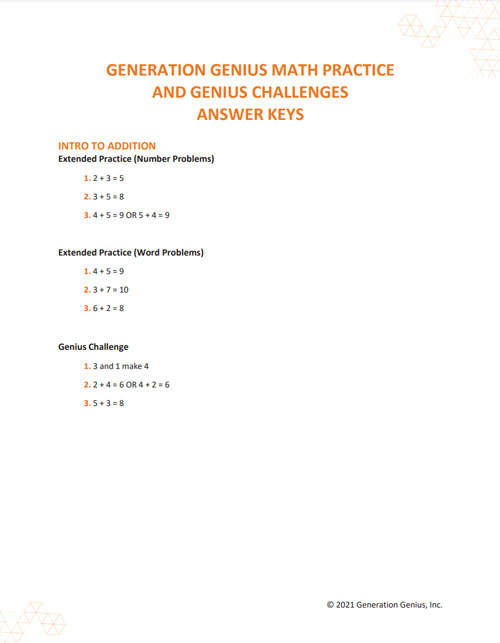Students learn and understand the process of adding and subtracting 3-digit numbers by using models such as base-10 blocks and number lines. Place value is emphasized in understanding adding or subtracting within each part of the numbers, and in understanding the relationship between each place when regrouping.
To better understand addition & subtraction within 1,000…
LET’S BREAK IT DOWN!
Weightlifting

Adding 3-digit numbers can help you find the total weight two people can lift. Let’s say Marco can lift 118 kg and April can lift 234 kg, how much can they lift together? We can figure this out by thinking of 118 as 100 + 10 + 8 and 234 as 200 + 30 + 4. Then we can add each place and regroup: 100 + 200 = 300, 10 + 30 = 40, and 8 + 4 = 12. We have 300 + 40 + 12, but 12 can be regrouped as 10 + 2. 300 + 40 +10 + 2 = 352. We can also use a number line, starting at 118 and moving 234. First we can hop 200, from 118 to 318. Then hop 30 to 348, and then 4 to 352.
Counting Treasure

Let’s say you find a treasure chest with 497 gold coins. Then, the next day you find a treasure chest with 310 coins. How many coins do you have altogether? We can think of 497 as 4 hundreds, 9 tens, and 7 ones, and 310 as 3 hundreds, 1 ten, and 0 ones. Then we can add by place: 400 + 300 = 700, 90 + 10 = 100, and 7 + 0 = 7, 700 + 100 + 7 = 807. The tens added to 100, making one more hundred, and no tens. The 0 shows there are no tens and that 8 is in the hundreds place. Also, since 497 is so close to 500, we could take 3 from 310 to give to 497, making 500 + 307. This is easier to add since only the hundreds need to be added and can be done mentally.
Farm Animals

Let’s say two farmers raise pigs for the county fair. The first pig weighs 257 kg and the other farmer’s pig weighs 142 kg. How much more does the first pig weigh than the second pig? We can write each number by place and then subtract. 257 is 200 + 50 + 7, and 142 is 100 + 40 + 2. Now we can subtract each place: 200 - 100 = 100, 50 - 40 = 10, and 7 - 2 = 5. 100 + 10 + 5 = 115, so the larger pig weighs 115 kilograms more than the smaller pig. Or, we can use a number line. We can start at the lesser number, 142, then jump forward to 257. First we’ll jump 100 to 242. Then we can jump 10 to 252, and then 5 to 257. Altogether we jumped 100 + 10 + 5, or 115.
Rock Concert T-shirts

Let’s say you have 900 t-shirts to sell at a rock concert. At the end of the concert you have 328 t-shirts left. How many shirts did you sell? To find out how many were sold, you need to find the difference between 900 and 328. Or you can think of the problem as 900 - ___ = 328 or 328 + ___ = 900. Again we can write each number by place value, but this time it’s a little different. There are no tens or ones to subtract, so we can regroup 1 hundred as 10 tens, then one of the tens as 10 ones. So now 900 is 800 + 90 + 10. 328 is 300 + 20 + 8, so now we can subtract. 800 - 300 = 500, 90 - 20 = 70, and 10 - 8 = 2. We have 500 + 70 + 2, or 372. So there are 372 t-shirts left after the concert. We can also use a number line to count up from 328 to 900. Start at 328 and jump 2 to 330. Now jump 70 to 400. Last, jump 500 to 900. We jumped 2 + 70 + 500, or 572. Try this one yourself: Let’s say Greg’s parents buy a computer for $567, but give the clerk $600. What will their change be?

































































































































 Select a Google Form
Select a Google Form








